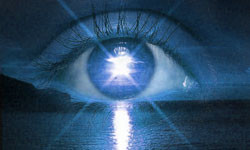In previous posts I’ve written about looking at pieces of the blur, in order to identify where you’re looking at and to keep stimulating your central vision to get it to wake up. But is that really what’s going on? Is it appropriate to direct so much of your energy on the pieces of blur that you see, when the blur is scattered light rays and is a distortion or misrepresentation of what’s actually there? By looking at a piece of the blur, what you’re really looking at is a detail that is actually from another spot and mixed with other details. It’s no wonder it’s so hard for you to process it and even figure out where you’re looking. How would you direct your attention, when the crossed light rays make it so what you think is in your central vision is really in your peripheral vision, and some of what you think are details in various spots in your peripheral vision are really what you’re looking at with your central vision?
The point is you can’t trust where you’re looking when you see so much blur. What, then, are you supposed to do? What do you have left to work with, if what you’re seeing in your central vision is causing further confusion and discomfort, and you’re seeing no improvement in your vision? To answer these questions, let’s segway to Benjamin Franklin.
“I conceive that the great part of the miseries of mankind are brought upon them by false estimates they have made of the value of things.” – Benjamin Franklin
That’s one of my favorite quotes. To me it means we largely create our own problems by putting too much stock in things that don’t matter or are just plain wrong.
If that’s true, then consider what it means for blurry vision. It would mean the blur that’s causing you so much grief for you is not as important as you think it is.
“But,” you say, “I want to see clearly, and I have to work with what I have, and in the blur is everything, and I can’t improve my vision by ignoring what I see.”
Chronic blur from chronically unfocused eyes is an indication that things have gone horribly wrong. It’s an indicator the same way that pain is an indicator. And if you let pain occupy your attention and continue unabated, it will wear you down. One solution is to take pain medication, which is analogous to wearing glasses. It may be an okay temporary solution if your problem is only temporary, but a better solution, if you can do it, is to sidestep it by occupying your mind intensely with something else.
So when you do anything to try to fix a blurry image and make it clear, you’re overestimating the value of the image that your eyes are taking in. What’s more important is the image formed in your mind. What can you imagine to be there? Take note of what you’re looking at, but then focus on visualizing what could be there, belied by the blur. Even vague bits and pieces in your mind is fine. You’re working on not only activating your atrophied visualization ability, but also synching it with what you’re looking at. That way your mind is intensely enough involved in the right way with what you’re seeing. Your eyes should start to focus better too, but remember the info from your eyes only makes up a part of what you see. Instead of noticing how blurry something appears, take it as an indication that you aren’t forming an image well enough in your mind to assist focusing. That way you’re not so concerned about what’s only coming in through your eyes and you’re instead focusing on your overall perception of what’s out there.
get help on our Facebook Group!

I founded iblindness.org in 2002 as I began reading books on the Bates Method and became interested in vision improvement. I believe that everyone who is motivated can identify the roots of their vision problems and apply behavioral changes to solve them.

